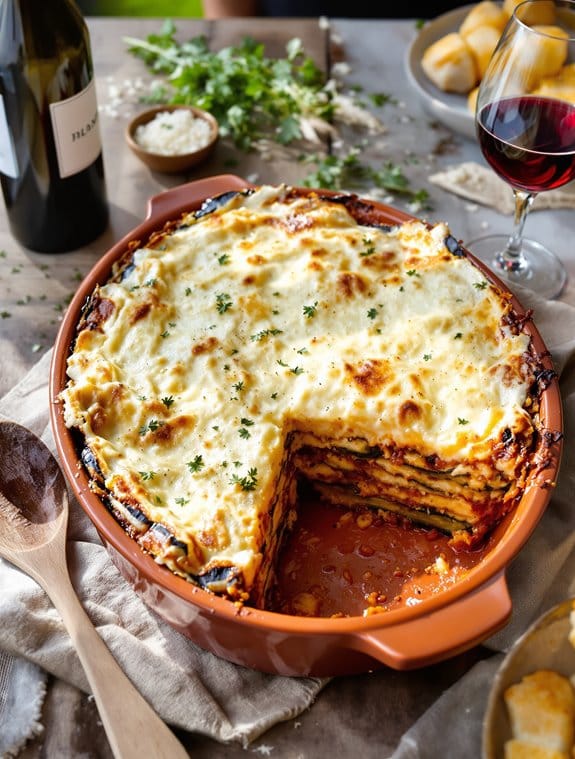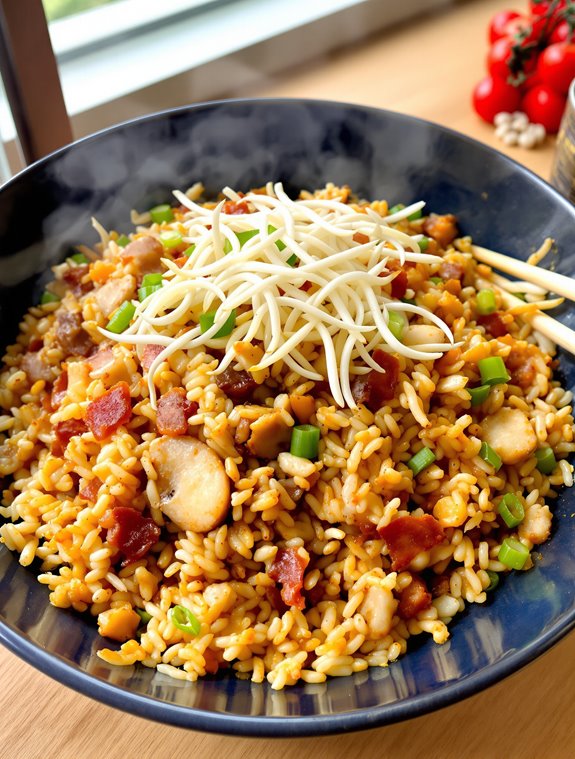Why You’ll Love this Authentic Greek Moussaka
If you’ve never experienced the heavenly layers of a traditional Greek moussaka, you’re in for a life-changing culinary adventure.
I’m obsessed with this dish because it combines creamy béchamel, savory tomato sauce, and tender eggplant into one magnificent casserole.
The rich combination of cinnamon and nutmeg creates an aroma that’ll have your neighbors wondering what magic you’re cooking up.
Trust me, the time spent layering is worth every minute when you cut into that perfectly set slice.
The crispy top gives way to silky layers beneath, creating a texture contrast that simply can’t be beat.
Comfort food perfection.
What Ingredients are in Authentic Greek Moussaka?
Authentic Greek moussaka is a showstopping dish that features layers of eggplant, rich tomato sauce, and a creamy béchamel topping. The combination of warm spices and multiple textures creates a Mediterranean masterpiece that’s worth every minute of preparation. While traditional recipes sometimes include meat, our version offers a delicious mushroom alternative that captures all the savory depth without the lamb or beef.
- 3 pounds eggplant, peeled and sliced vertically
- 2 large onions, peeled and minced
- 2 cups mushrooms, minced (or 1 pound ground beef/lamb if preferred)
- 3 tomatoes, peeled and pureed
- 3 tablespoons tomato paste
- 3/4 cup dry red wine
- 1/2 cup fresh parsley, chopped
- 1 tablespoon garlic, finely chopped
- 1 teaspoon cinnamon
- 1 tablespoon oregano
- 1 teaspoon sugar
- 4 cups milk
- 1/2 cup butter (plus 2 tablespoons for sautéing)
- 6 tablespoons flour (plus extra for dredging eggplant)
- 1/8 teaspoon nutmeg
- 1/4 teaspoon white pepper
- 2 tablespoons olive oil (plus more for frying eggplant)
- 4 eggs, beaten
- 2 cups ricotta cheese
- 1 cup dry breadcrumbs
- 2 cups kefalotyri or Parmesan cheese, grated
When shopping for ingredients, quality matters – especially for the eggplant, which forms the foundation of this dish. Look for firm, glossy eggplants without soft spots. The cheese is another critical component; while authentic Greek moussaka uses kefalotyri, Parmesan makes a perfectly acceptable substitute if you can’t find it at your local market. For vegetarians, the mushroom version offers incredible umami flavor, but meat lovers can easily substitute ground lamb or beef for a more traditional approach. Either way, don’t skimp on the cinnamon and nutmeg—these signature spices give moussaka its distinctive, aromatic character.
How to Make this Authentic Greek Moussaka
This authentic Greek moussaka comes together in three main components: the vegetable and tomato base, the eggplant preparation, and the creamy béchamel topping.
Start with the tomato sauce by sautéing 2 large onions in 2 tablespoons olive oil and 2 tablespoons butter until soft and golden, about 8 minutes. Add 2 cups minced mushrooms (or 1 pound of ground lamb/beef if you prefer) and sauté until cooked through.
Stir in 3 peeled and pureed tomatoes, 3 tablespoons tomato paste, 3/4 cup dry red wine, 1/2 cup chopped parsley, 1 teaspoon cinnamon, 1 tablespoon garlic, 1 tablespoon oregano, and 1 teaspoon sugar. Let this mixture simmer uncovered for 30-45 minutes until thick and reduced—the aroma that fills your kitchen during this step? Simply divine.
While your sauce simmers, prepare the 3 pounds of eggplant by peeling and slicing them vertically about 1/4 inch thick. Salt them and let them sit for 30 minutes (this draws out any bitterness), then rinse, pat dry, and dredge in flour.
Sauté the eggplant slices in olive oil until golden brown on both sides. For the béchamel, heat 4 cups milk until tiny bubbles form around the edges, then set aside. In another pan, melt 1/2 cup butter, whisk in 6 tablespoons flour until smooth, and gradually add the warm milk, stirring constantly until thick.
Remove from heat, add 1/8 teaspoon nutmeg and 1/4 teaspoon white pepper, then gently fold in 2 cups ricotta cheese and 4 beaten eggs. Now comes the assembly—layer eggplant, tomato mixture, breadcrumbs, and grated cheese in a greased baking pan, repeating until all ingredients are used.
Pour the béchamel over everything and bake at 300°F for an hour until beautifully golden. The hardest part? Waiting 20-30 minutes before cutting into it, but trust me, this resting time allows all those gorgeous layers to set properly.
Authentic Greek Moussaka Substitutions and Variations
While mastering the traditional recipe is rewarding, Greek moussaka welcomes thoughtful adaptations to suit dietary needs and ingredient availability.
Can’t find kefalotyri cheese? Parmesan works beautifully.
I’ve discovered that ground turkey can replace lamb for a lighter version, while vegetarians might enjoy doubling those mushrooms instead of meat.
For my gluten-free friends, almond flour substitutes nicely for the breadcrumbs and roux.
Dairy-free? Try coconut milk in your béchamel, though the flavor profile shifts slightly.
My personal favorite twist? Adding a layer of thinly sliced potatoes at the bottom—not traditional, but oh, the texture it creates.
What to Serve with Authentic Greek Moussaka
Greek moussaka deserves complementary sides that honor its rich, complex flavors without overwhelming this labor-of-love main dish.
I always serve mine with a simple Greek salad—just tomatoes, cucumbers, red onions, and feta with a lemon-olive oil dressing. Something bright and acidic cuts through the richness perfectly.
A basket of warm pita bread for sopping up those delicious sauces is non-negotiable in my house.
And for drinks? A crisp white wine like Assyrtiko or Moschofilero. Their minerality stands up beautifully to the creamy béchamel and savory filling. Nothing fancy needed—moussaka is already the star.
Final Toughts
After spending hours in the kitchen perfecting your moussaka, you’ll understand why this dish holds such a special place in Greek cuisine. The layers of eggplant, rich tomato sauce, and that heavenly béchamel create something truly magical when they meld together.
I’ve made this recipe countless times, and the 30-minute rest period after baking is non-negotiable, folks. Worth every minute of waiting. The flavors need time to settle, like a good story needs time to be told. Don’t you think the best dishes are the ones that demand a little patience?

Greek Moussaka
Ingredients
Equipment
Method
- Begin by preparing the eggplant. Peel and slice 3 pounds of eggplant vertically into 1/4 inch thick slices. Sprinkle with salt and let sit for 30 minutes to draw out bitterness.
- While the eggplant rests, start the tomato sauce. Heat 2 tablespoons olive oil and 2 tablespoons butter in a large pan over medium heat.
- Add the minced onions and sauté until soft and golden, about 8 minutes.
- Add the minced mushrooms (or ground meat if using) and cook until done.
- Stir in the pureed tomatoes, tomato paste, red wine, chopped parsley, garlic, cinnamon, oregano, and sugar.
- Simmer the sauce uncovered for 30-45 minutes until thick and reduced. Set aside.
- Rinse the salted eggplant slices and pat them dry with paper towels.
- Dredge each eggplant slice in flour, shaking off excess.
- Heat olive oil in a pan and sauté the eggplant slices until golden brown on both sides. Transfer to paper towels to drain excess oil.
- Prepare the béchamel sauce. Heat the milk in a saucepan until small bubbles form around the edges, then set aside.
- In another pan, melt 1/2 cup butter. Whisk in 6 tablespoons flour until smooth and cook for 1-2 minutes.
- Gradually add the warm milk to the flour mixture, whisking constantly until the sauce thickens.
- Remove from heat and add nutmeg and white pepper. Allow to cool slightly.
- Gently fold the ricotta cheese and beaten eggs into the béchamel sauce.
- Preheat the oven to 300°F (150°C). Grease a large baking dish.
- Begin assembling the moussaka. Place a layer of eggplant slices on the bottom of the dish.
- Spread a portion of the tomato sauce over the eggplant, then sprinkle with breadcrumbs and grated cheese.
- Repeat the layers until all ingredients are used, finishing with a layer of eggplant.
- Pour the béchamel sauce over the top, ensuring it covers the entire surface.
- Bake for approximately 1 hour until the top is golden brown.
- Allow the moussaka to rest for 20-30 minutes before cutting and serving. This resting time is crucial for the layers to set properly.




